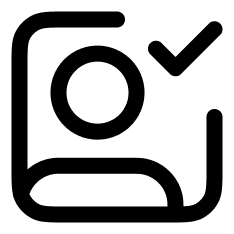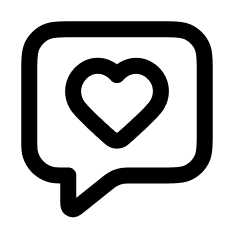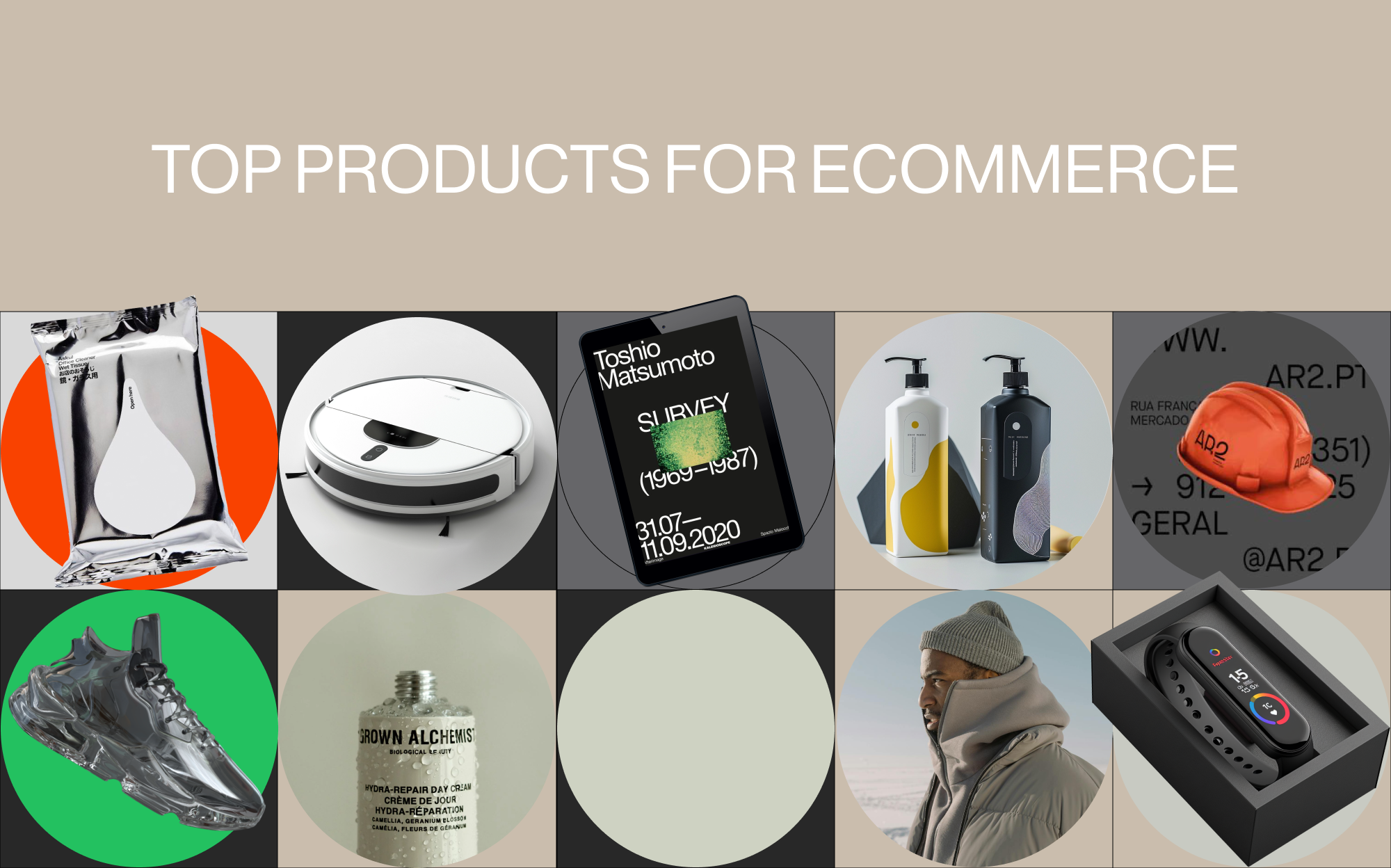
16 Trending Products to Sell in 2025
If you’re thinking about starting a new eCommerce business, you’ll have to figure out what to sell. Whether you’re retailing digital products, dropshipping electronics and gadgets, curating this year’s top fashion, or hopping on a new hobby trend, knowing which items are trending in 2025 is a great way to start your business.
But consumers are a fickle bunch, and what’s trending changes regularly! That’s why we’ve compiled a list of the top 15 products to sell in 2025, complete with data and statistics showing their upward trend. Ready to get started and sell?
Top products and trending items in 2024
Here are the different categories we will be covering. Each of these items were selected by our eCommerce teams as items that are selling well in 2024.
-
Health and beauty products
-
Tech, gadgets, and electronics
-
Digital-only products
-
Jewelry and accessories
-
Hobbies, arts, and crafts
-
Fashion and apparel
1. Vitamins and supplements
Vitamins and supplements have been in fairly consistent demand for decades but since 2020, both have been on a consistent upward trend. Vitamins have seen spikes during the winter months ever since, and supplements are experiencing a 20 year high in demand.
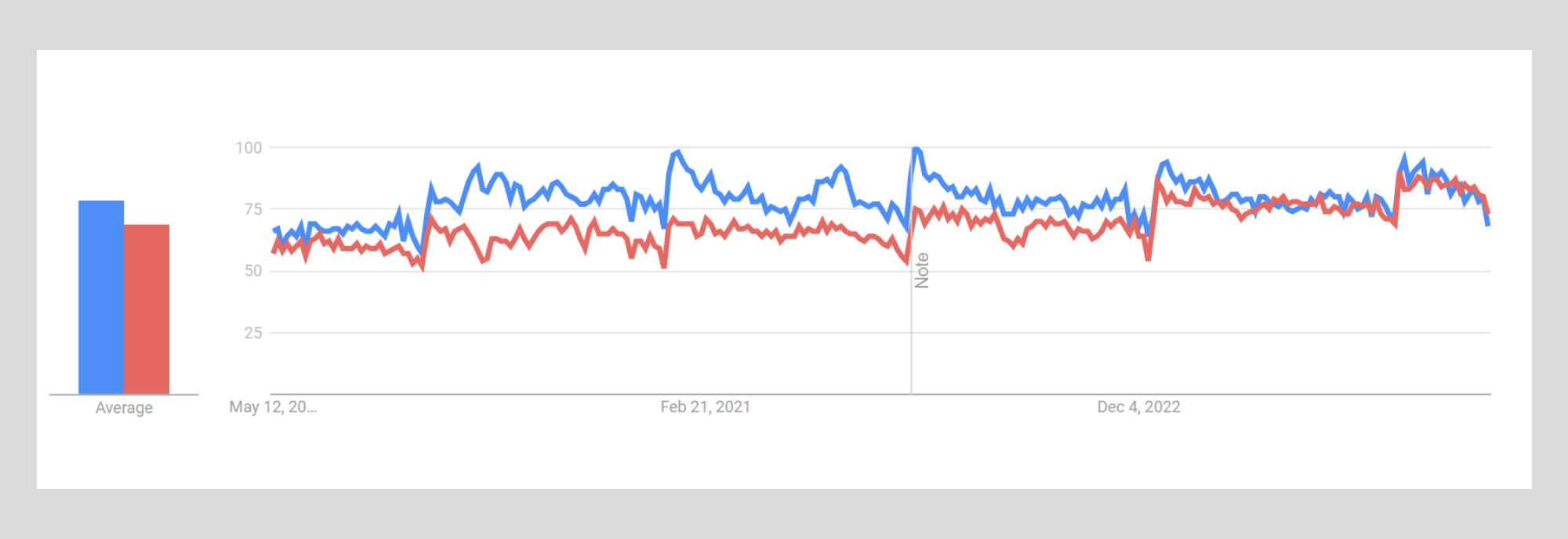
It’s safe to say that post-COVID, people are taking a greater interest in a healthy lifestyle. Pre-workout supplement and Vitamin D supplement Google searches have increased by over 1000% since 2019, stress-reducing ashwagandha has been on a steady rise since 2017, growing by over 400%, and dietary supplements have seen a 200% increase since 2004. Herb-based supplements like turmeric gummies are on a 700% 5-year rise, and this industry shows no signs of slowing down.
With retailers reporting an up to 50% profit margin, this product is no-brainer if you're just getting started in eCommerce.
2. Organic skin care products
Skincare started to trend back in 2017, but has grown exponentially since then, likely from the increase of beauty and health influencers. Regardless of how it happened, selling skincare products represents tapping into an industry that sees 300% more Google searches than at the beginning of 2018.
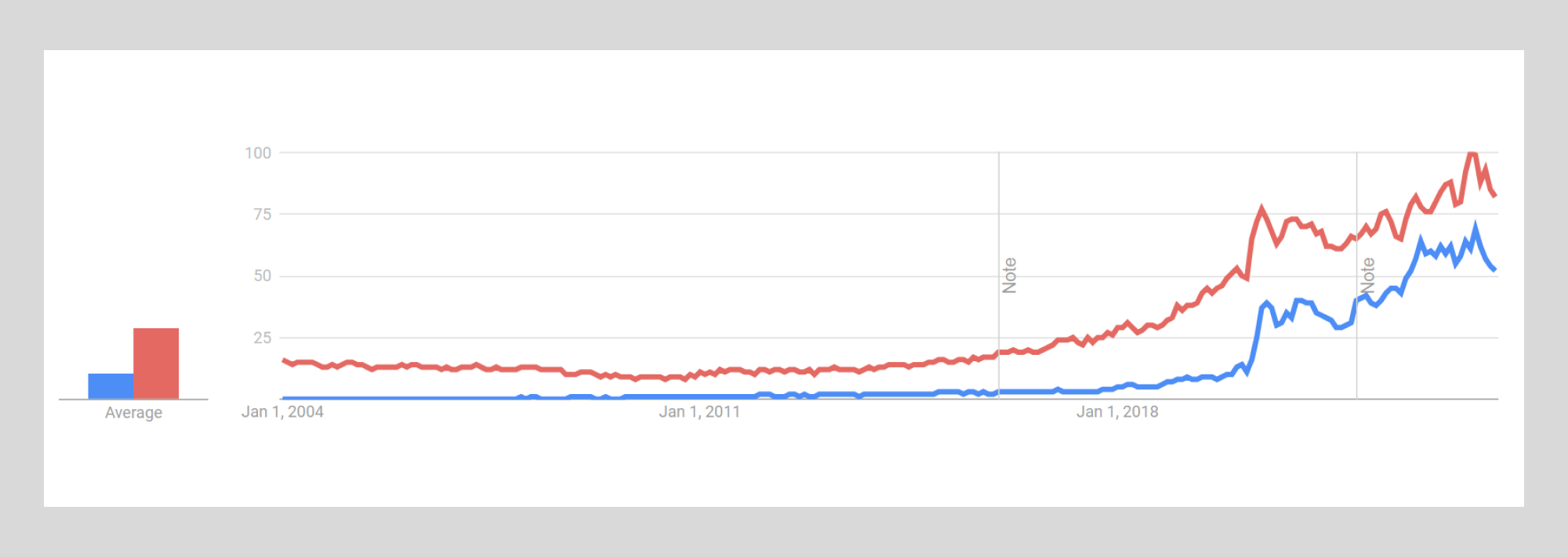
Red represents searches for skincare. Blue represents searches for CeraVe. Google Analytics
The skincare industry is on track to generate nearly $190 billion in 2025 with an annual growth rate of over 3% and a market share of over 40% of the overall beauty industry. South Korean skincare products are leading the way, and have enjoyed a 300% increase in search volume since early 2022. Natural skincare products have been somewhat rocky, but have maintained consistent interest for two decades, as have organic skincare products.
Considering high skincare industry growth projections and how easy it is to enter the market, this is an industry that should definitely be on your radar if you want to start an eCommerce business.
3. Fitness Trackers
Fitness trackers in general have settled as far as Google search volume, but the market is healthier than ever. The worldwide industry is projected to reach just short of $75 billion in 2025 with an annual growth rate of nearly 8.5%. That includes a user penetration rate increase from 5.6% to 6% by 2028, mainly in China where projections indicate the largest revenue streams will arrive.
If you’re interested in entering this industry, focus on fitness trackers that offer a lot of fitness and health related functionality, like run tracking, sports and cycling integration, heart rate, temperature and sleep monitoring, and trackers that can read a person’s glucose. Brands to take note of include Garmin (the Venu and Fenix series has been making waves in the industry), Fitbit, Amazfit, and Samsung. Apple Watches are of course worth mentioning, but consider that the Apple Watch 9 is the subject of a current legal battle that disables some of its health monitoring.
4. Robot vacuum cleaners
Robot vacuum cleaners are an item that see spikes in sales surrounding holidays, particularly Black Friday and Christmas. Rather than trending, these items are consistent sellers, routinely hitting search volumes that mirror each other year after year, holiday after holiday. The industry itself is growing as well, with a projected CAGR of over 10% between 2023 and 2032 and a market size value of over $4 billion as of 2022.
If you decide to enter this market, research will be required. The major players in the robot vacuum cleaner industry are yet to settle, with old players and new players taking top spots on ratings articles seemingly every month. At time of publishing, iRobot’s Roomba was still ranking high, but relative newcomers Ecovacs and Eufy are making progress alongside industry veterans Bissell and Shark. It’s an evolving industry and will require attention, but during the holidays this item should be quite lucrative.
5. Air purifiers
Air purifiers are another category that has remained relatively stable (outside of spikes during the early winter and mid-summer months) in terms of search volume but is a market that projections indicate will be worth nearly $3.5 billion by 2027 according to The Business Research Company. With COVID seemingly here to stay, and pollution rising as a main concern for average consumers, people are much more attentive of the air quality in their homes, which the same projections say will be responsible for market growth rate of 14% through 2027.
Simply put, air purification and treatment is a good niche market to get involved with as the competition is relatively low and startup costs can be as low as under $1,000. Dyson products are a good place to start for your premium line, but be sure to check out purifiers from Philips, Coway, Sharp, LG, and Xiaomi to fill your catalog.
6. Smart Watches
The smartwatch industry started in 2012 when Sony launched their Model MN2sw, but really took off in 2015 when Apple debuted their first Apple Watch. The industry has trended upward since then, though not without rough patches. Yet despite short term shortcomings, the market represents a projected revenue of almost $48 billion worldwide with expected a CAGR of 6.84% over the next four years.

Searches for ‘smart watch’ spike predictably before Black Friday and Christmas, but are on a slow upward trend. Google Trends
If you want to start selling smart watches, focus on big tech players like Apple, Garmin, Fitbit, Samsung, Huawei (if selling in China as they are banned in many other countries including the USA), and Amazfit. Be on the lookout for any new companies entering the market as well; according to Statista.com, 60% of the smartwatch market is still dominated by various brands, with Apple taking up 16%. Finally, make sure you understand your audience and are fulfilling their need for multiple-use devices. The current trend for new smartwatch buyers is health-focused, so products with extra sensors are playing a large role in consumer decisions.
7. Reusable water bottles and coffee mugs
Water bottles are an easy industry to get into and one that has been on a twenty-year uptrend as consumers grow tired of purchasing water and disposing of cheap plastic bottles. Recent success stories like the Stanley Cup craze of the 2023 holiday season or Yeti’s near decade-long holiday dominance show that interest in this $8.2 billion market is, if anything, gaining speed. Google Trends shows that since 2004, search volume for water bottles has increased by roughly 700%, making water bottle retail a stable and safe bet for new eCommerce businesses.
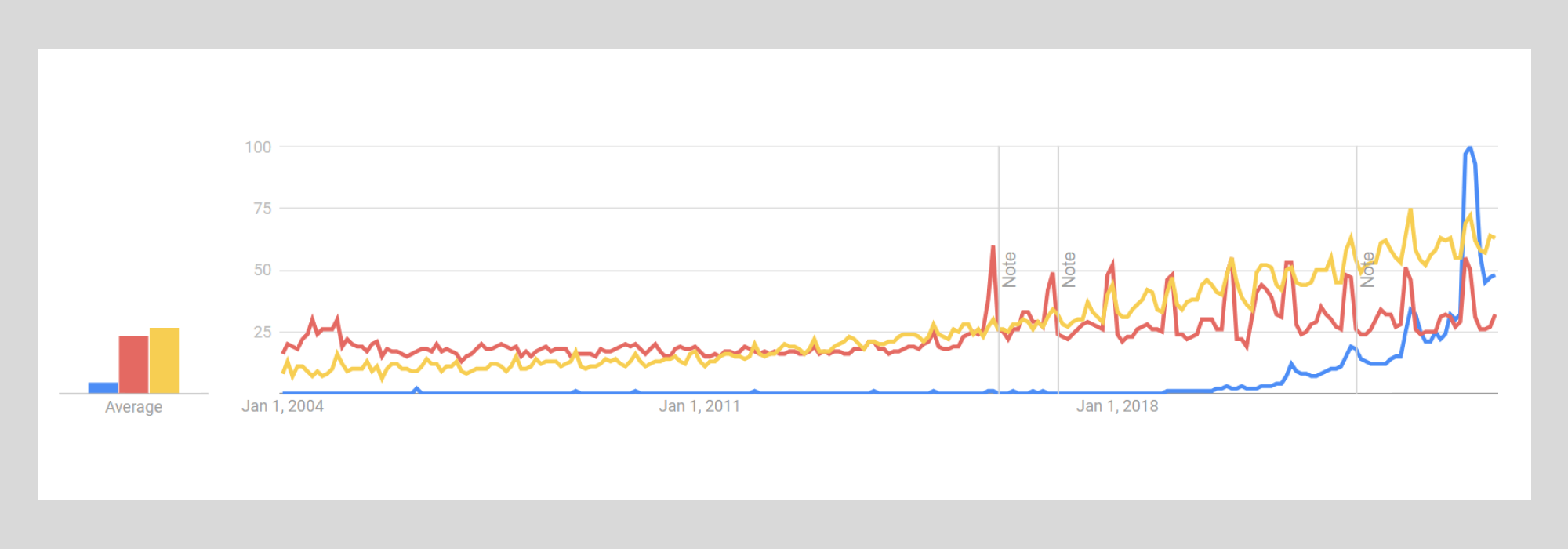
Yellow shows rising interest in water bottles, while red shows Yeti’s holiday dominance. Stanley’s recent surge is shown on the right. Google Trends
Besides Stanley and Yeti, consider offering bottles and insulated flasks from Takeya, Hydro Flask, CamelBak, Mira, and Thermos. Besides targeting popular brands, one easy way to make a splash in the water bottle industry is with customer water bottle graphics. You can even incorporate your logo for some free advertising.
8. Smart pillow
Selling smart pillows may not seem immediately appealing, but this niche market is one that is rapidly growing, with a CAGR of over 15% since 2017. The nascent industry generated more than $650 million in 2022, with experts predicting that demand for these devices will accelerate over the next 10 years. By 2033, they predict that the industry will be worth over $8 billion, representing a CAGR of over 21%.
Smart pillows help people snore less and relax better, track their sleep, and feature tech like speakers, temperature control, and alarm clocks. As the tech matures, demand will grow and prices will reduce. Tapping into this market now has the potential to be lucrative in the near future, especially as millennials and generation Z start owning homes of their own.
9. Online Courses
Since 2020, online-only services have become more popular, and that includes online courses and lessons. Selling online courses requires a methodical and serious approach, but, if you can satisfy these requirements, can be very profitable.
The online education market has been growing rapidly since 2020 and was projected to reach over $185 billion in 2024 with a CAGR of 8.56% for the next five years. By 2029, the number of online course users is expected to surpass one billion.
When selling courses online, consider self-hosting your courses. Having a dedicated website or eCommerce platform can allow you complete control so you can create engaging sales pages and optimize for search engines. Consider raising your reputation on existing online course websites because they already have existing audiences. Once you have a following, maintaining your own website will be much more sustainable, and you’ll have access to contact information for email marketing campaigns. Make sure you have community-building features so your audience can grow with you!
10. Digital memberships
Subscription models are more popular than ever and are present in nearly every industry. From groceries to the apps on your phone, subscriptions and digital memberships have become the prevalent method for consumers and businesses. Regardless of what your industry is, a subscription-based payment model should be included.

‘Subscription business model’ saw a sudden rise in search volume in 2021, and since then has maintained popularity. Google Trends
Make sure that when you’re designing your subscription model that you include multiple tiers and multiple payment options to accommodate a wide audience. Consider allowing crypto as a payment method as it is gaining popularity among merchants.
11. eBooks
If you’re looking for a good form of passive income, selling eBooks is a proven and effective method. The eBook industry continues to thrive, having surpassed a valuation of $17 billion in 2024, with a growth rate of 4.78%.
If you decide to start selling digital books online, the hard part is right in the beginning: writing the book. You’ll have to pick a topic, and the most profitable currently are children’s books, self-help books, money-making guides, short stories designed for eReaders, cook books, and mystery stories. Once you’ve written the book, you’ll only need to market your work, and manage your income.
Start by figuring out what your target audience is interested in reading. A good place to start is on Amazon where you can see what the best-selling ebook categories are. After picking your category, develop an outline, write your content, proofread and double check your work, and design your book. Now you can design a website around your book, and start selling it in PDF or EPUB formats.
12. Licensed digital content
Selling licensed digital content can be profitable and low effort. There is no need to replace or restock goods, you typically don’t have to ship anything to your customers, and can instead focus purely on improving your catalog. The only downsides are that often, you’ll be competing with free content, meaning you will need to focus on your competitive edge to justify your price.
If you want to focus on licensed digital content, stock photography, website themes, infographics, stock music, and stock video footage are a good place to start. The digital content market reached a value of just under $212 billion in 2020 and is projected to attain a CAGR of 14% through 2028.
13. Hair accessories
Once a market so strong that entire stores of hair accessories dotted malls worldwide, hair accessories are now considered a niche in brick-and-mortar stores. Instead, the market has moved online in a big way, growing by a CAGR of more than 8% since 2021 and seeing increased search volumes since 2020. The value of the market was just under $19 billion in 2021 and is projected to surpass $31 billion by 2028.
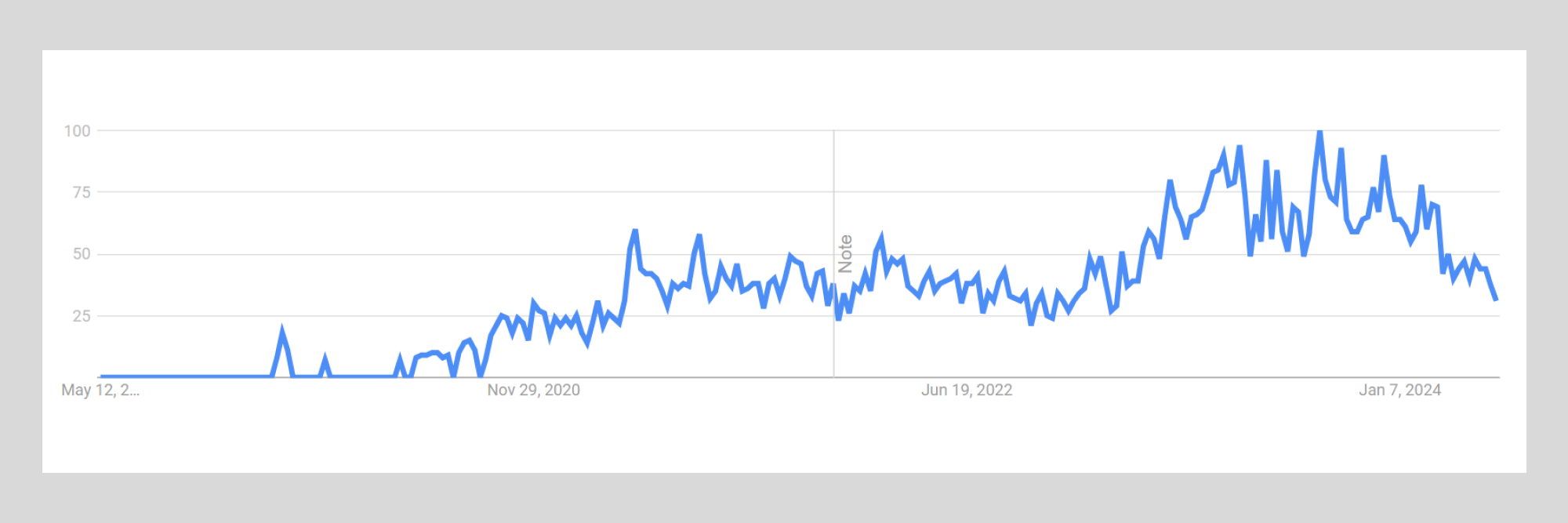
Shopping-based search results for ‘hair accessories’ have risen steadily since 2020. Google Trends
If you decide to start selling hair accessories, consider dropshipping and looking at regions like Asia Pacific and India. You’ll also have to keep up with trends as with any fashion industry product, and use social media to advertise. Finally, source your product carefully, as inexpensive products may be lacking in quality, while more expensive products may be difficult to sell, regardless of quality.
14. Recycled cashmere
Recycled cashmere is a difficult industry to categorize. It is undoubtedly growing in popularity, but the fabric has traditionally been a fit for the gift industry, with sales and searches spiking around holidays. Yet industry experts project that the cashmere clothing market, valued at over $3 billion in 2023, will continue to grow through 2030 with a CAGR of over 4%.
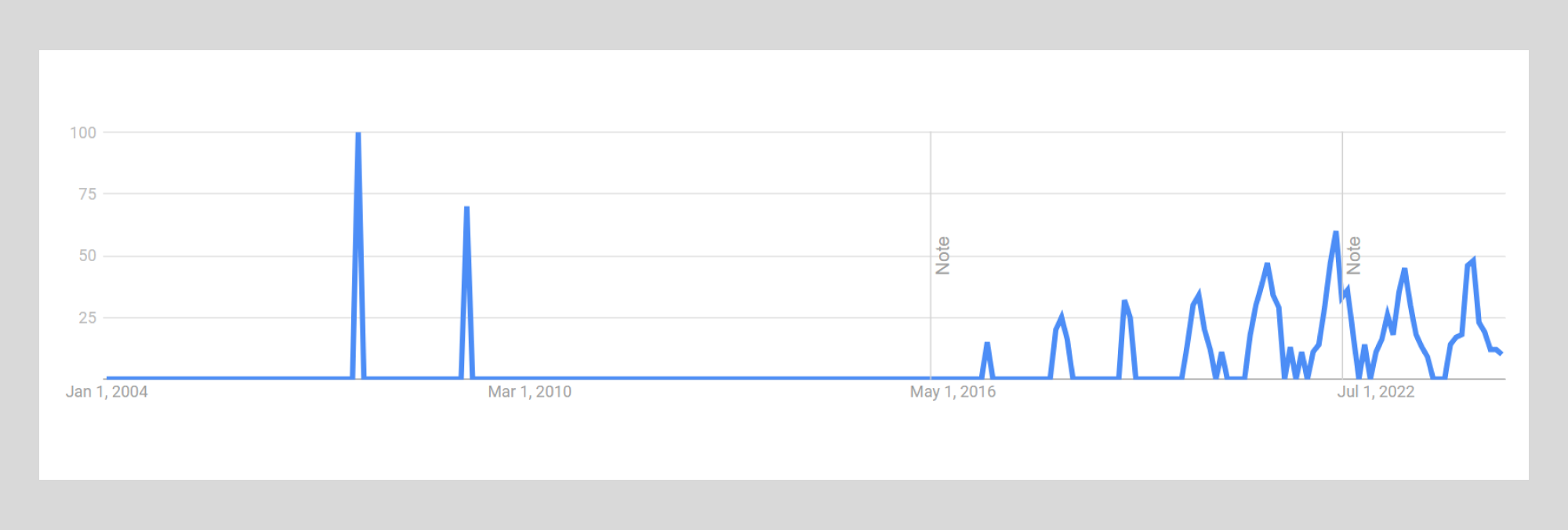
‘Recycled cashmere’ typically spikes from Oct to Jan, but since 2020, the annual baseline has been rising. Google Trends
Cashmere seems to be increasingly tied to recycling and studies say that consumers generally have a positive attitude towards goods made from recycled materials. Other studies, however, say that consumers are less likely to purchase goods made of recycled material, though through marketing and packaging techniques, you can avoid this issue.
15. Hand-painted pottery
People are increasingly interested in handmade or artisanal products, and that includes hand-painted pottery. In the home decor and interior design industries, pottery and ceramic sales have been quietly growing due to their aesthetic appeal, uniqueness, sustainability, and therapeutic benefits.
Since 2020, new hobbies have taken the limelight, including pottery and ceramics, many of which get shared across social media apps and sites. With this increased exposure, its small wonder that artisan and hand-painted pottery has become an item in demand.
This is a market you can enter relatively quickly and easily, especially if you’ve picked up the hobby. Just be aware that because the handmade nature of this item is the reason people are interested in it, you may have to charge higher prices than consumers may expect from more mass-produced options. If you feel comfortable reselling or producing these items, remember to expand your reach internationally, collaborate with other artists, and offer customization options to your customers.
16. Recycled clothing
Environmentally friendly and sustainability are taking a focus for consumers, and recycled clothing is one way that retailers are trying to lower the impact of manufacturing. Recycled clothing significantly reduces the impact of manufacturing, and lowers the amount of clothing thrown into landfills annually.
Recycled clothing suffers from some buyer apprehension, so branding and portrayal are important if you decide to retail them. Messaging is also important, as recycled clothing is typically sorted, washed, shredded, and repurposed well before making it to shelves. For further inspiration, take a look at some designers that are already embracing recycled clothing like Stella McCartney, Mara Hoffman, or Maggie Marilyn.
Start selling your products online
Regardless of what you decide to sell online, the second step should be to build a website for your product. Having your own website comes with several benefits, such as being able to learn more about your customers, establish your brand outside third-party marketplaces, learning more about what your customers want, redesign for holiday sales, and make your own rules for your online store.
Thankfully, making your own website and pairing it with an eCommerce solution, or even other online marketplaces, is easier than ever. Most web builders don't even require coding knowledge anymore, meaning you can hop right in and start creating your website, though be sure to check out some educational resources if you want your online storefront to stick out.
So get out there. Find something to sell and find out for yourself how accessible eCommerce is in 2025. Happy sales!
Related posts
446,005 entrepreneurs like you already have a head start
Become one of them by getting world-class expertise delivered into your inbox, for free.





